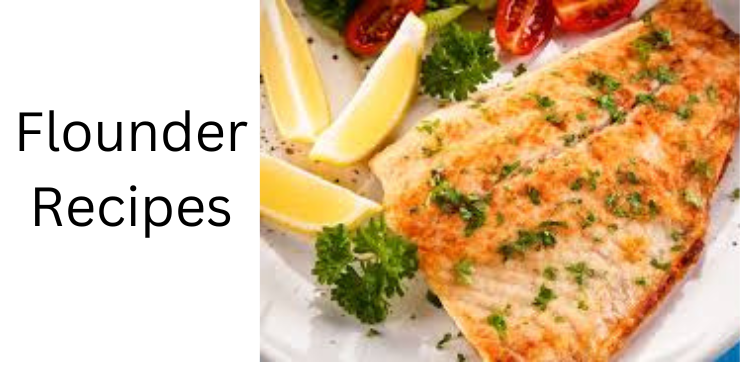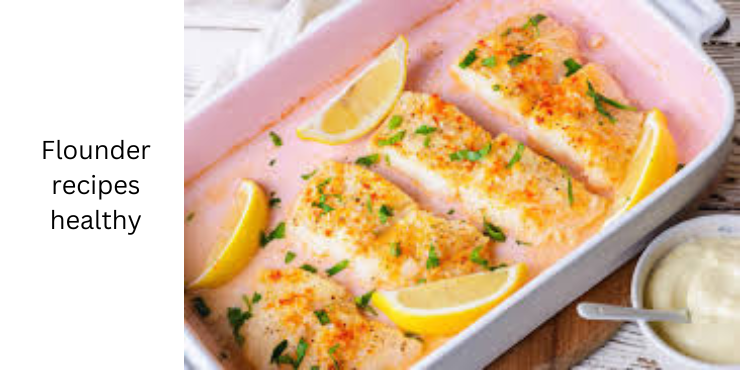Flounder is a versatile and delicious fish that can be a fantastic addition to any healthy diet. Packed with essential nutrients and boasting a delicate flavor, flounder can be prepared in various ways to suit different tastes and preferences. In this article, we’ll explore the health benefits of flounder, how to choose the best quality fish, and provide some mouthwatering and nutritious flounder recipes for you to try at home.
1. Introduction to Flounder

Flounder is a type of flatfish that belongs to the family Pleuronectidae. It is found in oceans around the world and is known for its distinctive flat body and unique swimming behavior. Flounder has a mild, sweet flavor and a delicate texture, making it a popular choice for seafood lovers.
2. Health Benefits of Flounder
High in Protein
Flounder is an excellent source of high-quality protein, making it an ideal food choice for those looking to increase their protein intake. Protein is essential for building and repairing tissues, supporting muscle growth, and maintaining overall health.
Rich in Omega-3 Fatty Acids
One of the key health benefits of flounder is its high omega-3 fatty acid content. Omega-3 fatty acids are essential fats that play a crucial role in brain function, heart health, and reducing inflammation in the body. Consuming flounder regularly can help lower the risk of heart disease and improve cognitive function.
Low in Calories
Flounder is also relatively low in calories, making it a great option for those watching their weight or trying to maintain a healthy diet. By incorporating flounder into your meals, you can enjoy a filling and satisfying dish without consuming excess calories.
3. Factors to Consider When Choosing Flounder
Freshness
When selecting flounder at the grocery store or fish market, it’s essential to choose fish that is fresh and of high quality. Look for flounder fillets that are firm to the touch, with a mild scent of the sea. Avoid fish that smells overly fishy or has slimy or discolored flesh.
Sustainability
Another factor to consider when choosing flounder is sustainability. Look for flounder that has been sourced from sustainable fisheries or farms to ensure that you’re making an environmentally responsible choice.
4. Tips for Cooking Flounder
Flounder can be cooked in various ways, including baking, grilling, and pan-searing. Here are some tips for cooking flounder to perfection:
Baking
Baking flounder is a simple and healthy cooking method that results in tender and flavorful fish. To bake flounder, season the fillets with herbs, spices, and a squeeze of lemon juice, then place them in a preheated oven and bake until cooked through.
Grilling
Grilling flounder adds a delicious smoky flavor to the fish and creates beautiful grill marks on the surface. Brush the flounder fillets with olive oil and seasonings, then grill them over medium heat until they are cooked and slightly charred on the edges.
Pan-Searing
Pan-searing is a quick and easy way to cook flounder on the stovetop. Heat a skillet over medium-high heat, add a drizzle of olive oil, and sear the flounder fillets for a few minutes on each side until they are golden brown and cooked through.
5. Healthy Flounder Recipes
Baked Flounder with Lemon and Herbs
Ingredients:
- 4 flounder fillets
- 2 tablespoons olive oil
- 2 cloves garlic, minced
- 1 teaspoon dried oregano
- 1 teaspoon dried thyme
- Salt and pepper to taste
- 1 lemon, thinly sliced
- Fresh parsley, chopped (for garnish)
- Lemon wedges (for serving)
Instructions:
- Preheat your oven to 375°F (190°C). Line a baking dish with parchment paper or lightly grease it with olive oil.
- Place the flounder fillets in the prepared baking dish.
- In a small bowl, mix together the olive oil, minced garlic, dried oregano, dried thyme, salt, and pepper.
- Drizzle the seasoned olive oil mixture over the flounder fillets, making sure they are evenly coated.
- Place lemon slices on top of each fillet.
- Bake in the preheated oven for about 12-15 minutes, or until the flounder is cooked through and flakes easily with a fork.
- Once done, remove from the oven and garnish with chopped fresh parsley.
- Serve the baked flounder hot with lemon wedges on the side.
Grilled Flounder with Mediterranean Salsa
Ingredients:
- 4 flounder fillets
- 2 tablespoons olive oil
- 1 tablespoon lemon juice
- 2 cloves garlic, minced
- 1 teaspoon dried oregano
- Salt and pepper to taste
- For the salsa:
- 1 cup cherry tomatoes, halved
- 1/2 cucumber, diced
- 1/4 red onion, finely chopped
- 2 tablespoons fresh parsley, chopped
- 2 tablespoons fresh lemon juice
- Salt and pepper to taste
Instructions:
- In a small bowl, whisk together the olive oil, lemon juice, minced garlic, dried oregano, salt, and pepper.
- Brush the flounder fillets with the olive oil mixture and let them marinate for 15-30 minutes.
- Meanwhile, prepare the salsa by combining the cherry tomatoes, cucumber, red onion, parsley, lemon juice, salt, and pepper in a bowl. Mix well and set aside.
- Preheat your grill to medium-high heat. Place the marinated flounder fillets on the grill and cook for 3-4 minutes per side, or until they are cooked through and have grill marks.
- Remove the flounder from the grill and serve hot with the Mediterranean salsa on top.
Pan-Seared Flounder with Garlic Butter
Ingredients:
- 4 flounder fillets
- 2 tablespoons olive oil
- 2 cloves garlic, minced
- 2 tablespoons unsalted butter
- 1 tablespoon fresh lemon juice
- Salt and pepper to taste
- Fresh parsley, chopped (for garnish)
Instructions:
- Season the flounder fillets with salt and pepper on both sides.
- Heat the olive oil in a large skillet over medium-high heat. Add the minced garlic and cook for 1-2 minutes, or until fragrant.
- Add the flounder fillets to the skillet and cook for 2-3 minutes per side, or until they are golden brown and cooked through.
- Once the flounder is cooked, add the butter to the skillet and let it melt, stirring to coat the fish.
- Remove the skillet from the heat and squeeze fresh lemon juice over the flounder fillets.
- Garnish with chopped fresh parsley and serve hot.
6. Conclusion
In conclusion, flounder is a nutritious and delicious fish that can be incorporated into a healthy diet in various ways. Whether baked, grilled, or pan-seared, flounder provides an excellent source of protein, omega-3 fatty acids, and other essential nutrients. By following the tips and recipes provided in this article, you can enjoy flavorful and satisfying flounder dishes that are good for your health.
7. FAQs
Q1: Is flounder a sustainable seafood option? A1: Yes, flounder can be a sustainable seafood choice when sourced from responsibly managed fisheries or farms.
Q2: Can I substitute flounder with other types of fish in the recipes provided? A2: Yes, you can substitute flounder with similar white fish varieties such as sole, cod, or haddock.
Q3: How should I store fresh flounder fillets? A3: Store fresh flounder fillets in the refrigerator wrapped in plastic wrap or aluminum foil. Use them within 1-2 days for the best quality.
Q4: Are there any other health benefits of eating flounder? A4: In addition to being high in protein and omega-3 fatty acids, flounder is also a good source of vitamins and minerals, including vitamin B12, vitamin D, and selenium.
Q5: Can I freeze leftover cooked flounder? A5: Yes, you can freeze leftover cooked flounder in an airtight container for up to 2-3 months. Thaw it in the refrigerator before reheating and consuming.

